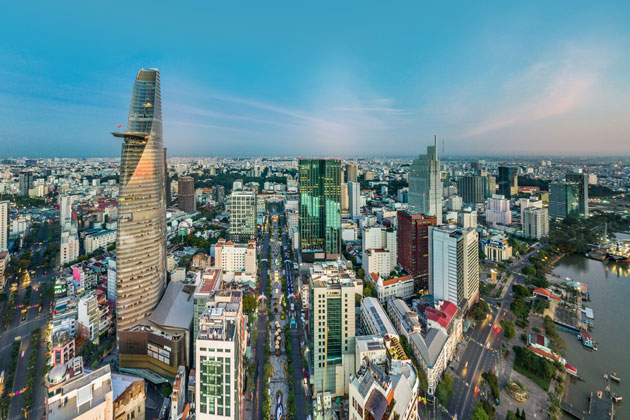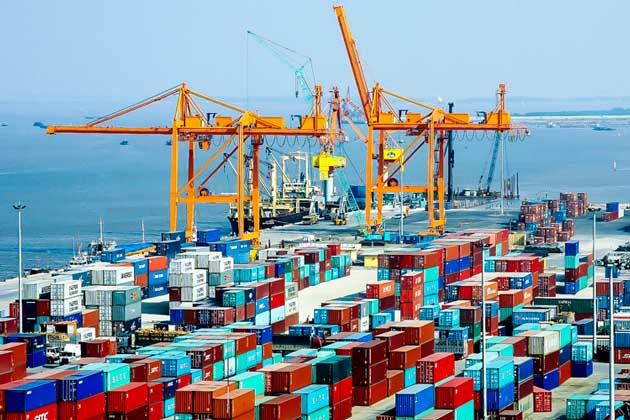China’s weakened global position has created new opportunities for other emerging economies. Among the various countries that need to grow foreign investment and expand their manufacturing sectors, Vietnam is undoubtedly one of the main beneficiaries of the US-China trade war, absorbing much of China’s lost manufacturing capacity.
China is known as “the factory of the world“, with a massive global production output that exceeds that of any other country.
According to data released by the United Nations Statistics Division, China’s manufacturing output climbed from $3,460.33B to $3,896.35B between 2017 and 2019, accounting for approximately 30% of total global output. And, of course, for many years, China has been at the forefront of manufacturing, outpacing many other prospective rivals, including the United States.
Most strikingly, according to The Economist, the world’s manufacturing superpower – China, produces just 3% less of global output in 1990. So, why is this position being rocked, and why are investors shifting to other countries, most notably Vietnam?
What happened with China?
After months of threats, US Former President Donald Trump decided to impose sweeping tariffs on China for alleged unfair trade practices in July 2018.
Since then, the two nations have been embroiled in countless back-and-forth negotiations, a tit-for-tat tariff war, foreign technology restrictions, and fought several WTO cases, pushing US-China trade tensions to the verge of a full-blown trade war.
The US has slapped tariffs on US$550 billion worth of Chinese products. China, in turn, has set tariffs on US$185 billion worth of US goods.

Both sides have also threatened qualitative measures that would affect US businesses operating in China. For months, neither Trump nor China’s President, Xi Jinping, indicated a desire to back down.
But finally, on January 15, 2020, the two nations signed the Phase One Deal, in which they officially agreed to roll back tariffs, expand trade purchases, and renew commitments on intellectual property, technology transfer, and currency practices.
However, this did not appear to be of any help in the current situation.
Following the impact of the subsequent pandemic outbreak, which resulted in the disruption of global supply chains and serious economic fallout, most severely in China, many companies have started to come up with the idea to diversify their global supply chains away from this country. Some have even made actions by moving a significant production out from China and investing in Vietnam with complete trust.
Most notably, Apply Inc., one of the biggest names in tech, announced that they will manufacture approximately 30% of their AirPods for the second quarter in Vietnam instead of China and that they would most likely set up production for the new Macbook lines and the new iPad in this promising country.
Another tech giant – Samsung, contributes a quarter of Vietnam’s exports, while Intel chose this country to house its biggest chip assembly plant worldwide.
According to a recent McKinsey Global Institute study, many companies will likely shift a quarter of their global product sourcing to new countries over the next five years, while climate risks, cyber-attacks, and even the ongoing pandemic are only going to accelerate this trend.
Vietnam – the world’s next manufacturing hub

China’s manufacturing engine has largely stalled after decades of dramatic growth.
With rising wages, labor turbulence, environmental devastation, and business issues, China is no longer an appealing location for US and European manufacturers to locate their operations.
This tepid global economy and trade growth opens vast opportunities for developing countries to thrive in manufacturing. In this uncertain trade environment, it goes without saying that a growing number of countries are optimistic about replacing China as the world’s next central manufacturing hub.
Among countless articles mentioning the shift of production from China as well as which country will become the new manufacturing powerhouse, Vietnam is always at the top of the list with tons of compliments.
Some support Vietnam’s efforts to accelerate economic growth, others admire its economic modernization, which has contributed enormously to the stimulation of production growth and the future potential.
But to win the trust of foreign investors and large corporations, what exactly does Vietnam have to offer?
Vietnam gains the most during two years of trade dispute

The flourishing opportunities that this trade redirection provides to Vietnam, other Southeast Asian countries and Mexico may even outweigh the negative consequences of the two-year conflict.
This conclusion is shared by related experts, including the Asian Development Bank’s (ADB) Chief Economist – Yasuyuki Sawada, who stated that “for non-China emerging economies, the positive impact dominates,” and that “the gain seems to be the largest for countries that can produce similar products to those made in China.“
So far, Vietnam has emerged as the clear winner among those who have benefited the most, with an additional $6.4 billion accrued during the two years of conflict, which is almost twice the country’s total annual health care spending.
This is due in part to the fact that countries such as Vietnam have long positioned themselves as alternatives to China for foreign manufacturers. “Vietnam has progressively ramped up manufacturing, attracting foreign investors and increasing exports to the US,” says Khiem Vu – Vietnam manager at Global Resources.
According to him, the trade war has hastened multinational companies’ decision to leave China.
“Many have forced their current Chinese manufacturers to shift production to Vietnam. For example, Chinese manufacturers of Crocs (foam shoes) have developed multi-thousand-worker factories in Phu Tho that only serve the US market.“
Khiem Vu – Vietnam manager at Global Resource
Vietnam economy is Asia’s shining star during COVID-19
To start off, over-reliance on China has become riskier for global manufacturers of all kinds as a result of the US trade war, pandemic-related supply chain disruptions, and higher costs.
Their relocation next door supported Vietnam’s manufacturing industry, which at its peak expanded 21% annualized in February, before the COVID lockdown.

Concerning Viet Nam’s achievements in the COVID-19 battle, a BBC News article from the United Kingdom notes that, while the nation lacks the cutting-edge health infrastructure like what of many wealthier countries, it has been widely praised for all the public health measures, which have rapidly brought numbers under control.
Furthermore, the article stated that Viet Nam has mitigated the economic damage caused by COVID-19 and has become the only country in South East Asia on track for growth in 2020.
“The country has seen slower growth this year and its once-thriving tourism sector has taken a particularly bad hit, but it has avoided the worst economic effects of the pandemic,”
BBC News
In reference to the country’s efforts to restore the economy amid the COVID-19, the BBC News highlights Viet Nam’s exports to the United States, which have risen by 23% in the first three quarters compared to the same period in 2019.
So it means that Vietnam’s economy, despite the pandemic, continues to record positive growth and exhibits strong growth patterns, prompting investors to favorably regard the country as a solid investment destination.
Vietnam’s workforce
In dealing with these global transitions, Vietnam has relied on one of its most valuable assets: its abundant, affordable, and competent labor force.
The backbone of Vietnamese economic growth is a diverse trade structure, increasing wages, and domestic consumption.
Nonetheless, labor costs still remain competitive, which helps in attracting foreign investment.

With the average Vietnamese monthly wage of about US$321, compared to the regional average of US$1,835 in 2020, it’s no surprise that Vietnam’s low labor costs are one of its most appealing characteristics to importers.
Vietnam was once recognized as a country with abundant labor resources and a young population. However, since Vietnam is experiencing a demographic transition to an aging society, while the size of Vietnam’s workforce continues to grow, the country’s youth population is shrinking. So what Vietnam is aiming for now is that besides continuing to rely on its workforce size and how affordable it is, it also requires focusing on making its workforce more productive.
In other words, Vietnam believes that a well-trained workforce is critical to the country’s economic success and the preparation for any transitions.
That’s why Vietnamese employers are looking for a mix of high-quality cognitive, behavioral and technical skills.
Furthermore, as implementing international labor standards is essential to increasing national competitiveness, Vietnam has joined the International Labor Organization conventions in order to make its labor market more compliant with the global market economy.
Well established manufacturing facilities and massive capability

The first factor that many corporations consider when deciding to relocate their production to Vietnam is whether Vietnamese companies can actually manufacture their desired product and adapt to the target quantity.
Importers who have experience sourcing from China know that it is easy to find a manufacturer for almost any product type in China. And not just one manufacturer, in Vietnam, you can find tens, if not hundreds, of manufacturers with a similar skill set and product manufacturing. Machinery, garments and textiles, footwear and headwear, food and beverage, and metals are among the top exports of the country.
Vietnam’s investment landscape is divided into three main zones in the north, center, and south of the country. Out of these three regions, investors typically end up investing in the north and south of the country.
Particularly, Vietnam’s northern areas are well-positioned as a destination for China+1(*) manufacturing and are well known for heavy manufacturing, oil and gas, and more recently for high-end manufacturing processes, such as auto manufacturing, etc.
Though considered as a developing nation, Vietnam can provide low production costs and offer the highest manufacturing quality possible at the same time.
At this point, it can be said that Vietnam can offer the approximate level of diversity as China. But the country’s manufacturing industry is more diverse than that of some other alternative sourcing destinations, such as Bangladesh and Cambodia. So this implies that Vietnam has adequate facilities and capacity as China to satisfy the production needs of most international businesses.
(*)China+1: the business strategy to avoid investing only in China and diversify the business into other countries
Stable political environment and favorable policy to promote international business collaboration
Security is one of the most important reasons why foreign businesses choose to invest in Vietnam.
Fortunately, Vietnam’s greatest advantage is the economic and political stability, and it is one of the most politically stable countries in South East Asia.
In a place where many countries are still vulnerable to political and economic instability, Vietnam has benefited from a stable government and social structure, making it an ideal destination for foreign investment. The CPV is in control. Alongside maintaining the one-party state system, safeguarding territorial integrity, and maintaining social order, its primary aim is economic growth.
Over the last 30 years, Vietnam has made remarkable progress in its development journey by transformed from one of the world’s poorest countries to a lower-middle-income country after implementing critical economic reforms in 1986 to move toward a limited market orientation.
The GVN’s long-term goal is to move from lower-middle-income to upper-middle-income status by 2035.
To maintain the exceptional growth trend while avoiding the middle-income trap, Vietnam must address key challenges, including economic policy and governance, infrastructure and energy needs, strengthening private sector competitiveness, and workforce capacity. In addition, the role of international projects and trade policy in boosting economic growth in Vietnam can not be overlooked.
Vietnam-EU free trade agreement

The EU-Vietnam Free Trade Agreement (EVFTA) entered into force on August 1, 2020, paving the way for increased trade between the EU and Vietnam by removing nearly 99% of customs duties between the two countries.
According to the Ministry of Planning and Investment (MPI), the FTA is expected to boost Vietnam’s GDP by 4.6% and exports to the EU by 42.7% by 2025. While the European Commission predicts that the EU’s GDP will rise by $29.5 billion by 2035.
Analysts anticipate that the trade agreement will provide a much-needed boost to Vietnam’s industries, as tariff elimination will benefit key export sectors such as smartphone and electronic product manufacturing, textiles, footwear, and agricultural products such as coffee. The FTA will encourage the expansion of these sectors, both in terms of capital and employment, as it enters 2021, increasing Vietnam’s export volume to the EU.
Regional Comprehensive Economic Partnership

The Regional Comprehensive Economic Partnership (RCEP), which was recently signed on November 15, 2020, expands on ASEAN’s free trade agreements and will foster economic integration and shape future trade policy.
The RCEP covers 15 countries, including ASEAN members (of which Vietnam is a member), Australia, China, Japan, South Korea, and New Zealand. Just like the recently ratified EVFTA and the Comprehensive and Progressive Agreement for Trans-Pacific Partnership (CPTPP), the RCEP will reduce tariffs, set trade rules, and help link supply chains, especially as governments deal with the COVID-19 consequences.
Conclusion
Answering the question “Manufacturing in the world: where next?” Vietnam clearly comes out on top, with significantly stepped-up efforts to attract manufacturing investments into the country.
Based on the foundation of constant innovation in economic and trade policies, strengthening infrastructure, improving labor quality, and so on, it is hoped that “Made in Vietnam” products will become widely popularized in the near future, assisting Vietnam to replace China as the world’s new manufacturing center.


